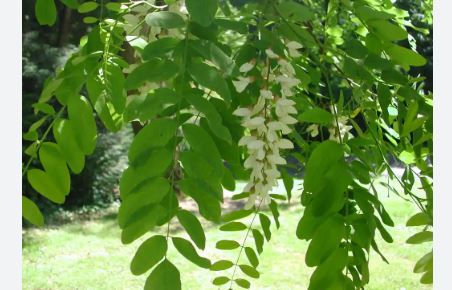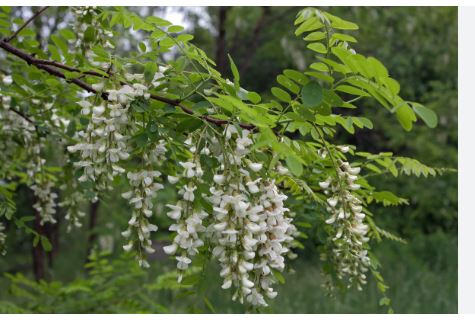
Locust trees, part of the Fabaceae family, are fast-growing, deciduous species primarily from North America, with some native to Africa and Asia. Belonging to genera like Robinia and Gleditsia, they thrive in USDA zones 3-9, tolerating poor soils, drought, and urban conditions. Known for their feathery, pinnate leaves and often thorny branches, they add texture and shade to landscapes. Their hard, durable wood and vibrant flowers make them valuable for both ornamental and practical uses.
Historically, locust trees have been prized for their tough wood, used by early settlers for fence posts, tools, and firewood. Indigenous peoples utilized their seeds and bark for food and medicine, while modern cultivation focuses on ornamental cultivars with thornless or seedless traits. Their ability to fix nitrogen in soil enhances agricultural landscapes, though some species are considered invasive due to aggressive spreading.
Characteristically, locust trees range from small shrubs (6-10 feet) to large trees (up to 100 feet), with leaves turning golden yellow in fall. Fragrant flowers, typically white or pink, attract pollinators, and seed pods provide food for wildlife. Some species have thorns, while others are bred thornless for safety. Their wood, often yellowish or reddish-brown, is valued for its strength and rot resistance.
Locust trees are used for shade, windbreaks, erosion control, and timber production, with their wood ideal for furniture, fencing, and crafts. In landscaping, they suit lawns, streets, or parks due to their adaptability and aesthetic appeal. However, their invasiveness and potential for suckering require careful management. Choose disease-resistant, thornless cultivars for urban settings and plant in full sun with well-drained soil for optimal growth.

Locust Trees
Black Locust (Robinia pseudoacacia)
The Black Locust, also called False Acacia or Yellow Locust, is a medium-sized deciduous tree (30-50 feet) native to the Appalachian Mountains and central U.S. Its dark gray, furrowed bark and pinnate leaves (8-14 inches) with 11-19 oval leaflets turn golden yellow in fall. Fragrant, white, wisteria-like flowers bloom in spring, followed by 2-4-inch purple-brown seed pods. The yellowish wood is exceptionally hard, used for fence posts, furniture, and firewood. Thriving in zones 3-8, it tolerates poor soils and fixes nitrogen, but its invasiveness and thorny suckers require careful management.
Honey Locust (Gleditsia triacanthos)
Honey Locust, native to central and eastern North America, grows 60-100 feet with a broad canopy, ideal for shade. Its bipinnate, fern-like leaves (6-8 inches) turn bright yellow in fall, and small, greenish-white flowers appear in late spring. The reddish-brown wood is durable for furniture and fencing, while its sweet, edible pods attract wildlife. Thriving in zones 3-9, it tolerates drought, salt, and urban conditions. Thorny branches (up to 8 inches) are a hallmark, though thornless cultivars exist. Plant in full sun with well-drained soil.
Bristly Locust (Robinia hispida)
Bristly Locust, a shrub-like tree (6-10 feet) native to the southeastern U.S., features pink to purple, pea-like flowers and reddish-brown pods with bristly hairs. Its pinnate leaves (7-15 leaflets) and fine, purple-brown hairs on young stems give it a unique texture. Ideal for small gardens or groundcover, it thrives in zones 5-8 in full sun and well-drained, neutral to alkaline soils. Its invasiveness and suckering habit require control, but its vibrant blooms attract pollinators. The wood is less used due to its small size.
New Mexico Locust (Robinia neomexicana)
Native to the southwestern U.S., the New Mexico Locust (15-25 feet) boasts light purple to pink flowers, unusual for Robinia species, which typically have white blooms. Its fern-like leaves (4-6 inches) have a grayish hue due to fine hairs, turning yellow in fall. The light gray-brown bark has shallow furrows. Thriving in zones 4-8, it prefers full sun and well-drained soils, tolerating heat and drought. Used for ornamental landscaping and erosion control, its wood is less commercially significant but durable.
Sunburst Honey Locust (Gleditsia triacanthos ‘Suncole’)
The Sunburst Honey Locust, a thornless and seedless cultivar, grows to 30-40 feet with a rounded canopy. Its bright yellow new foliage matures to green, offering striking fall color. Small, greenish flowers are inconspicuous, and it produces minimal pods, making it low-maintenance. Thriving in zones 4-9, it tolerates urban pollution, poor soils, and drought, ideal for lawns or streets. The reddish-brown wood is strong but less harvested due to its ornamental focus. Plant in full sun for best growth.
Shademaster Honey Locust (Gleditsia triacanthos ‘Shademaster’)
Shademaster Honey Locust, a thornless and seedless cultivar, reaches 40-50 feet with a broad, upright canopy, perfect for dappled shade. Its dark green, fern-like leaves turn golden yellow in fall. Thriving in zones 4-9, it tolerates extreme conditions like salt, drought, and compacted soils. The reddish-brown wood is durable but rarely used, as this cultivar is prized for landscaping. Plant in full sun with well-drained soil, ensuring 15 feet from pavement to avoid root issues.
Twisty Baby Locust (Robinia pseudoacacia ‘Twisty Baby’)
Twisty Baby, a dwarf Black Locust cultivar (8-10 feet), features contorted branches and pinnate leaves, creating a unique, sculptural look. Its white, fragrant flowers bloom in spring, and it produces few pods. Thriving in zones 4-8, it adapts to clay, loam, or sandy soils with a wide pH range (4.6-8.2). Ideal for small gardens or containers, its wood is not commercially used but adds ornamental value. Plant in full sun or partial shade for year-round interest.
Imperial Honey Locust (Gleditsia triacanthos ‘Imperial’)
Imperial Honey Locust, a thornless cultivar, grows to 30-35 feet with a compact, rounded canopy. Its bright green, pinnate leaves turn yellow in fall, and it produces few pods, reducing mess. Thriving in zones 4-9, it tolerates urban conditions, drought, and poor soils. The reddish-brown wood is strong but less utilized, as this tree excels as a lawn or street tree. Plant in full sun with well-drained soil and mulch to protect the trunk.
Skyline Honey Locust (Gleditsia triacanthos ‘Skyline’)
Skyline Honey Locust, a thornless cultivar, reaches 45-50 feet with a pyramidal canopy. Its dark green leaves turn golden yellow in fall, and it produces minimal pods. Thriving in zones 4-9, it handles urban pollution, salt, and drought, making it ideal for streets or parks. The reddish-brown wood is durable but primarily ornamental. Plant in full sun with well-drained soil, spacing 15-20 feet from structures to accommodate its deep roots.
Frisia Black Locust (Robinia pseudoacacia ‘Frisia’)
Frisia Black Locust, a striking cultivar (30-50 feet), features golden-yellow foliage that contrasts with its white, fragrant spring flowers. Its pinnate leaves and thorny branches add texture, though it produces few pods. Thriving in zones 4-8, it prefers full sun and well-drained soils but can tolerate poor conditions. Widely planted as an ornamental, its wood is hard but less used due to its invasive tendencies in some regions, like Australia.
Clammy Locust (Robinia viscosa)
Clammy Locust, native to the southeastern U.S., grows 20-40 feet with sticky, glandular hairs on young stems, giving it a “clammy” feel. Its pink to rose flowers bloom in spring, followed by 2-4-inch pods. The pinnate leaves turn yellow in fall. Thriving in zones 4-8, it prefers full sun and well-drained soils. Used for ornamental planting and erosion control, its wood is durable but less harvested. Its invasiveness requires monitoring.
Moraine Honey Locust (Gleditsia triacanthos ‘Moraine’)
Moraine Honey Locust, a thornless and nearly seedless cultivar, grows to 30-40 feet with a spreading canopy. Its bright green, fern-like leaves turn golden in fall, offering dappled shade. Thriving in zones 4-9, it tolerates urban conditions, drought, and alkaline soils. The reddish-brown wood is strong but rarely used, as this tree is prized for landscaping. Plant in full sun with well-drained soil, ensuring space for its 30-foot spread.
Purple Robe Locust (Robinia pseudoacacia ‘Purple Robe’)
Purple Robe Locust, a Black Locust cultivar (30-50 feet), features vibrant purple-pink flowers and an oval, upright canopy. Its pinnate leaves turn yellow in fall, and it produces few pods. Thriving in zones 4-8, it adapts to clay, loam, or sandy soils with neutral to alkaline pH. Ideal for modern or romantic gardens, its wood is hard but less used due to its ornamental focus. Plant in partial shade for best blooms.
Water Locust (Gleditsia aquatica)
Water Locust, native to the southeastern U.S., grows 40-60 feet in wetland areas, with bipinnate leaves and small, greenish flowers. Its reddish-brown pods (1-2 inches) contain 1-3 seeds, and its wood is durable for fencing. Thriving in zones 6-9, it prefers moist, acidic soils and full sun. Less common in landscaping, it’s valued for erosion control in swampy sites. Its thorns and pods require management in cultivated areas.
Rose Acacia (Robinia hispida var. rosea)
Rose Acacia, a cultivar of Bristly Locust (6-10 feet), is a shrub-like tree with lush, deep green leaves and pink to purple flowers in spring. Its reddish-brown pods have a bristly “beard,” adding exotic appeal. Thriving in zones 5-8, it prefers full sun and well-drained, chalky or sandy soils. Ideal for borders or small gardens, its wood is not commercially significant but enhances ornamental landscapes. Its invasiveness requires control.